Washing your hair extensions the right way keeps them looking fresh and lasting longer. Wondering how to wash hair extensions without causing damage? Just detangle gently, use sulfate-free shampoo, rinse with cool water, condition, and let them air dry.
Follow this GoviHair guide to keep your clip-ins, tape-ins, or synthetic extensions soft, shiny, and beautiful.
Why Washing Hair Extensions Properly Matters?
Washing your hair extensions isn’t just about keeping them clean, it’s essential for preserving their quality, longevity, and natural appearance. Extensions are a beautiful way to add volume, length, and style flexibility, but without proper care, even the most expensive sets can quickly become dry, tangled, or unusable.
Washing your hair extensions removes dirt, oils, and product buildup, ensuring they stay soft, shiny, and manageable. For human hair extensions, like Govihair’s durable Vietnamese hair, proper washing can help them last 2–3 years.
The Difference Between Washing Natural Hair vs Extensions
Natural hair benefits from the scalp’s natural oils, which keep strands nourished and resilient. Hair extensions, however, don’t have this built-in support system. Since they aren’t connected to the scalp, they don’t receive sebum, making them more vulnerable to dryness, frizz, and brittleness, especially after washing.
This is why extensions need extra care. The wrong washing routine can strip away what little moisture they have, leading to matting, breakage, and loss of shine. Proper washing isn’t just a beauty ritual, it’s a form of protection that ensures your extensions remain as sleek and silky as the day you bought them.
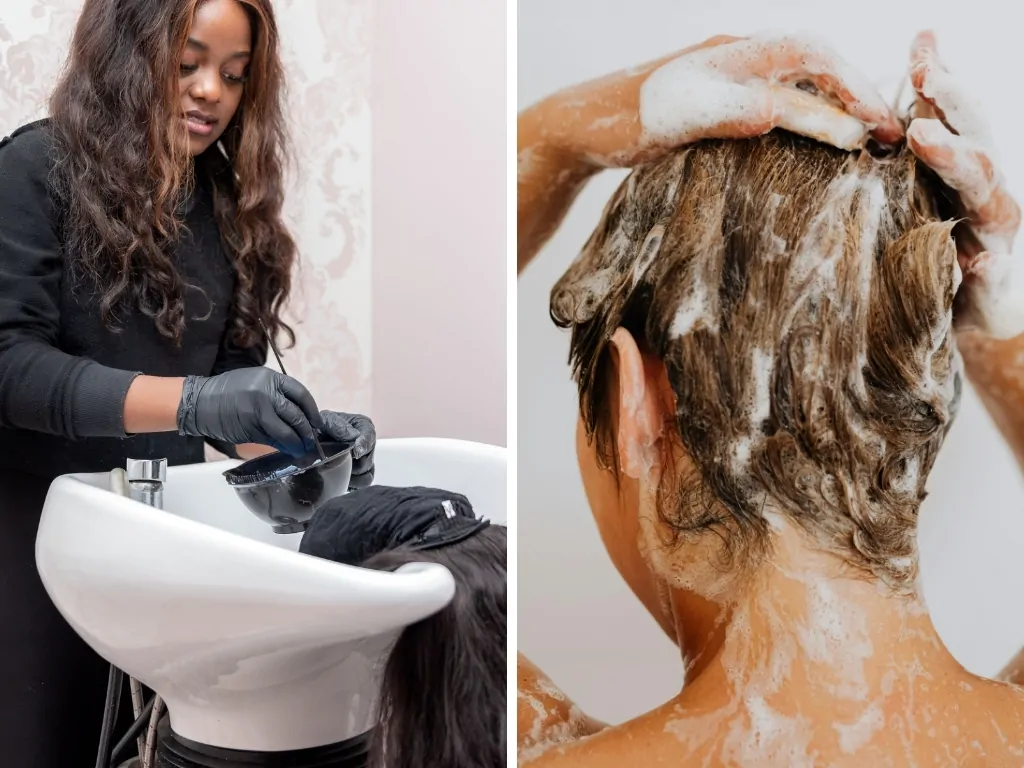
Common Mistakes That Can Ruin Your Extensions
If your extensions start looking worn out after just a few washes, chances are you’re making one (or more) of these common mistakes:
- Using shampoos with sulfates or alcohol: These harsh ingredients strip away moisture and weaken the hair fibers. Always opt for sulfate-free, extension-safe products to maintain softness and shine.
- Washing too often: Overwashing can dry out the hair, causing it to become brittle. Clip-ins should only be washed every 15–20 wears, while semi-permanent types like tape-ins or sewn-ins usually need washing just once a week.
- Scrubbing or twisting hair aggressively: Rough handling can tangle the hair and loosen bonds or wefts. Gentle downward motions work best when cleaning extensions.
- Blow drying at high heat without a protectant: Heat damage is one of the fastest ways to ruin both human and synthetic extensions. Always apply a heat protectant and use the lowest heat setting possible.
- Storing damp extensions: Moisture left in the hair can lead to mildew, odor, and bacterial growth. Always make sure your extensions are completely dry before storing them.
Avoiding these mistakes is the first step toward extending the life of your extensions. With a little care and the right technique, your extensions can stay smooth, soft, and gorgeous for months.
>> Read More: Top 8 Trending Easy Hairstyles That Hide Extensions
How To Wash Hair Extensions: Tools And Products You’ll Need
Before you begin washing your hair extensions, it’s important to have the right tools and products on hand. Using the wrong items, even just once, can compromise the texture, structure, and lifespan of your extensions. The following essentials will help you clean your extensions thoroughly while minimizing damage.
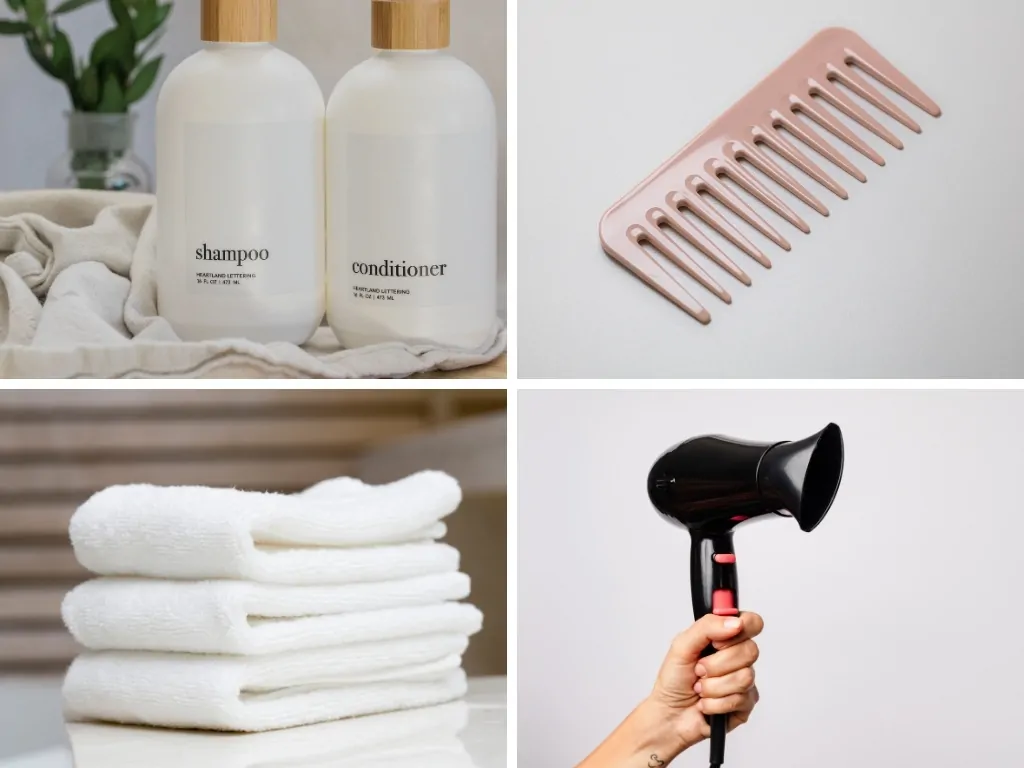
Extension-Safe Shampoos and Conditioners
Not all shampoos are created equal, especially when it comes to hair extensions. Traditional shampoos often contain sulfates, alcohols, and parabens that strip moisture, weaken bonds, and cause tangling. Extensions especially human hair types, require gentle, hydrating products that preserve softness without buildup.
Look for shampoos and conditioners labeled as:
- Sulfate-free – to prevent dryness and frizz
- Alcohol-free – to avoid brittleness and breakage
- Paraben-free – to reduce irritation and product buildup
Detangling Brush or Wide-Tooth Comb
Extensions can be prone to tangling, especially after washing. That’s why a detangling brush or wide-tooth comb is essential.
These tools help you:
- Gently remove knots without tearing the hair
- Work through tangles starting from the ends upward, preventing unnecessary tension on bonds or wefts
- Reduce breakage and maintain the smooth texture of the strands
Avoid using regular bristle brushes, especially on wet hair, as they can snag and stretch the strands, damaging both the hair and the bonds.
Pro tip: Detangle before washing and again after drying, using a leave-in conditioner to make the process easier.
Clean Towel and Drying Options
After rinsing your extensions, the drying process plays a crucial role in preserving their integrity. The type of towel you use and how you dry the hair can either protect or ruin your investment.
- Microfiber towels are the gold standard for drying hair extensions. They are ultra-absorbent and create less friction than traditional cotton towels, which helps reduce frizz, tangles, and breakage.
- Avoid rubbing or wringing the hair. Instead, gently blot or squeeze out excess water with the towel.
Once towel-dried, decide whether to air dry or blow dry:
- Air drying is the safest method, especially for synthetic or delicate extensions. Lay them flat on a clean towel or hang them up using extension hangers.
- Blow drying is acceptable for human hair extensions, but always use a heat protectant spray and the cool or low-heat setting on your dryer.
By using these recommended tools and products, you’ll create the ideal foundation for clean, manageable, and long-lasting extensions.
Step-by-Step: How to Wash Hair Extensions at Home
Washing your hair extensions at home doesn’t have to be intimidating. Whether you’re dealing with clip-ins, tape-ins, or wefts, following the correct washing technique will keep them looking smooth, shiny, and tangle-free. Human hair extensions, such as Govihair’s 100% raw Vietnamese human hair, require care similar to your natural hair. Below is a detailed step-by-step process designed to clean your extensions effectively while preserving their softness and structure.
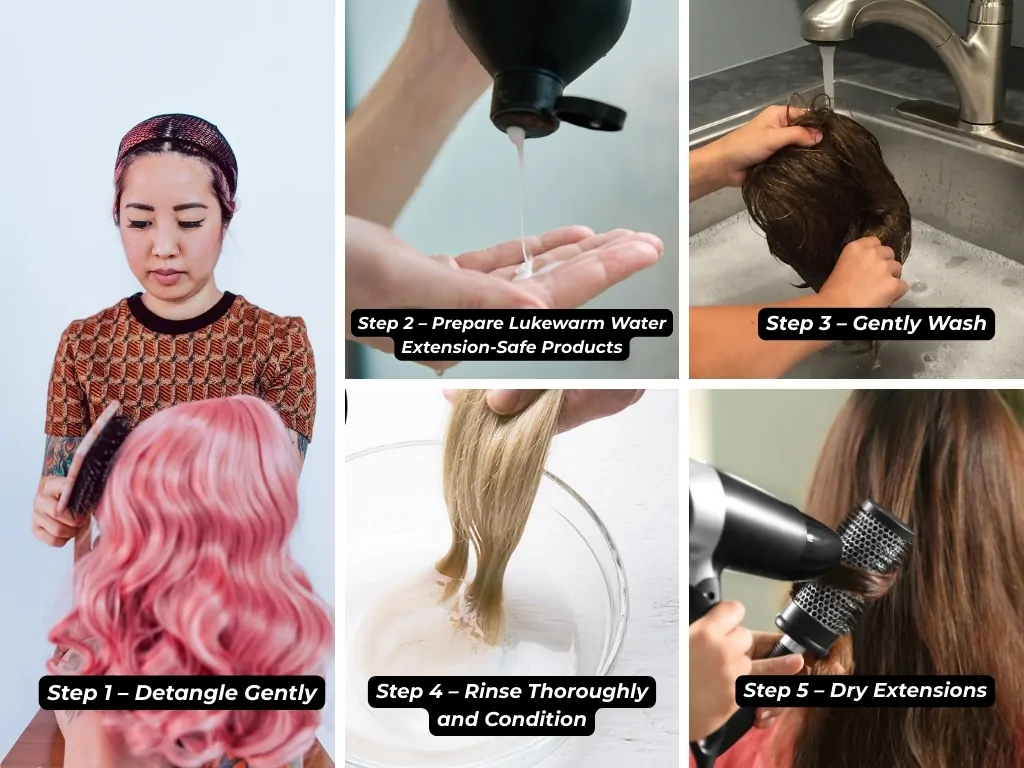
Step 1 – Detangle Gently Before Washing
Gently brush your extensions with a wide-tooth comb or a loop brush designed for extensions, starting from the ends and working up to the roots. This prevents matting and reduces stress on the hair.
- For clip-in extensions: Lay them flat and detangle each weft individually.
- For semi-permanent extensions: Be extra gentle around the root area to avoid loosening the bonds or tapes.
Skipping this step could cause tangling during the wash, which may lead to matting and even irreversible damage.
Step 2 – Prepare Lukewarm Water and Extension-Safe Products
Fill a clean basin, sink, or large bowl with lukewarm water, not hot, as heat can weaken the structure of both synthetic and human hair extensions.
- Add a small amount of sulfate-free shampoo and swirl gently to mix.
- If you’re washing clip-ins, submerge them one at a time for better control.
For sewn-in or tape-in extensions still attached to your scalp, wet the hair in the shower and gently massage the shampoo downward using your fingertips. - Use warm water to avoid stripping the natural oils from your extensions.
- Use a ratio of 1 shampoo – 3 moisturizing conditioner to maintain the hair’s smooth texture. Govihair’s Vietnamese hair, known for its natural shine, responds well to gentle moisturizing products.
Always avoid circular scrubbing or flipping the hair over, which causes tangling and stress on the fibers.
Step 3 – Gently Wash Without Scrubbing
Once wet, apply shampoo gently in downward strokes. If you’re washing loose extensions, hold them at the top while using your other hand to glide the product downward. Apply a small amount of shampoo, lathering gently from top to bottom. Avoid scrubbing or twisting to prevent tangling.
- Rinse thoroughly with lukewarm water, ensuring no shampoo residue remains.
Avoid:
- Piling the hair in your hands
- Rubbing the strands together
- Massaging in circular motions
These actions can rough up the cuticle, cause matting, and leave your extensions frizzy or damaged. For sewn-in or tape-in extensions, focus shampoo on the scalp and let the soapy water cleanse the lengths passively.
Step 4 – Rinse Thoroughly and Condition
After shampooing, rinse the hair under clean lukewarm water, again keeping the motion downward. Ensure no shampoo residue is left behind, especially near bonds or roots.
Apply a lightweight conditioner from the mid-length to the ends. Never apply conditioner directly on the bonds or tape area, as it can weaken adhesion.
- Leave the conditioner on for 3–5 minutes to soften and hydrate the strands.
- Rinse thoroughly until the water runs clear and the hair feels slick but not greasy.
Optional: Use a leave-in conditioner spray if the extensions are feeling particularly dry or if you plan to heat-style them later.
Step 5 – Dry Extensions the Right Way
How you dry your extensions is just as important as how you wash them.
- Start by gently blotting the hair with a microfiber towel. Avoid rubbing, wringing, or twisting.
- For clip-ins: Lay each weft flat on a dry towel or hang them using extension hangers in a well-ventilated area.
- For attached extensions: Let your hair air dry as much as possible, and avoid sleeping on damp extensions.
If you need to use a blow dryer, be sure to:
- Apply a heat protectant spray first
- Use the cool or low heat setting
- Dry in a downward motion to smooth the cuticle
Avoid high heat, especially on synthetic extensions, which can melt or frizz.
By following these five key steps, you’ll not only keep your extensions fresh and clean, but also preserve their silky feel, natural shine, and beautiful texture. Make washing part of your regular maintenance routine, and your extensions will look salon-styled for weeks on end.
How to Wash Hair Extensions Based on Type
Each type of hair extension comes with its own structure, attachment method, and care considerations. While the general washing steps remain similar, the key to long-lasting, flawless extensions lies in tailoring your routine to the type you’re using. Below are the most important requirements and precautions for each type.
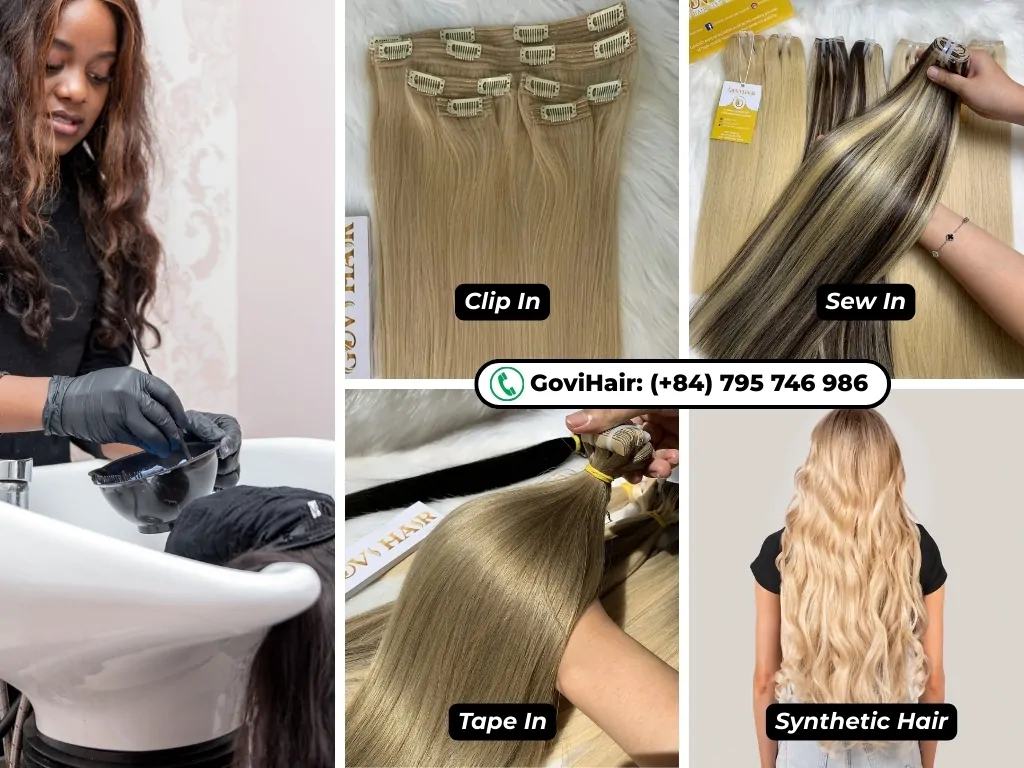
How To Wash Hair Extensions Clip-In
Clip-ins are removable and the easiest to manage, but they still require proper care to avoid tangling and dryness.
Key requirements:
- Always remove before washing.
- Wash only when needed, typically after 15–20 wears or when there’s visible buildup.
- Handle each weft individually and gently; avoid scrubbing or rubbing.
- Allow to air dry flat or on a hanger for best shape retention.
Watch out for: Overwashing, which can dry out the hair and weaken the clips over time.
How To Wash Hair Extensions Tape In
Tape-ins are semi-permanent and require extra caution to prevent tape slippage or adhesive breakdown.
Key requirements:
- Avoid applying shampoo or conditioner near the tape bonds.
- Use lightweight, sulfate-free products to reduce residue buildup.
- Focus cleansing and conditioning from the mid-length to the ends only.
- Be gentle during washing to avoid loosening the tape.
Watch out for: Oils, silicones, and conditioners near the scalp—they can weaken the tape and cause the extensions to slip prematurely.
Sewn-In Hair Extensions (Weaves)
Sewn-ins stay in for several weeks, so regular but gentle washing is crucial to avoid scalp buildup, odor, or mildew.
Key requirements:
- Use a diluted shampoo to easily reach the scalp through the braids.
- Massage the scalp gently in a downward motion to prevent tangling the weave.
- Rinse thoroughly to remove all product buildup, especially near the braid base.
- Ensure both the extensions and your natural hair underneath dry completely.
Watch out for: Incomplete drying, this can lead to mold, scalp irritation, and unpleasant smells.
How To Wash Hair Extensions Synthetic
Synthetic extensions have a completely different fiber structure and require minimal maintenance, but they’re more sensitive to heat and friction.
Key requirements:
- Wash infrequently, only when visibly dirty or after several uses.
- Use cool water and products specifically designed for synthetic hair (or a fabric softener rinse).
- Never expose to heat unless labeled “heat-resistant.”
- Always allow to air dry naturally, no towel rubbing or blow drying.
Watch out for: High heat and harsh cleansers. These can cause synthetic fibers to melt, frizz, or lose their shape permanently.
>> See more: What are the best hair extensions for short hair?
How Often Should You Wash Hair Extensions?
Keeping your extensions clean is essential, but overwashing can strip them of moisture and shorten their lifespan. Unlike natural hair, extensions don’t produce oils, so they don’t need to be washed as often. The frequency depends on the type of extension, how often you wear them, and the amount of styling product used.
Signs Your Extensions Need a Wash
Not sure when it’s time to wash your extensions? Look out for these common signs:
- Noticeable product buildup: A sticky or stiff texture caused by accumulated hairspray, dry shampoo, or oils.
- Dull or greasy appearance: Extensions start to lose their natural shine and look weighed down or oily.
- Loss of natural movement: Hair feels heavy, limp, or tangles more easily than usual.
- Unpleasant odor: A musty or sour smell often indicates sweat or moisture was trapped during storage or after a previous wash.
These symptoms indicate it’s time to freshen up your extensions with a gentle, proper wash.
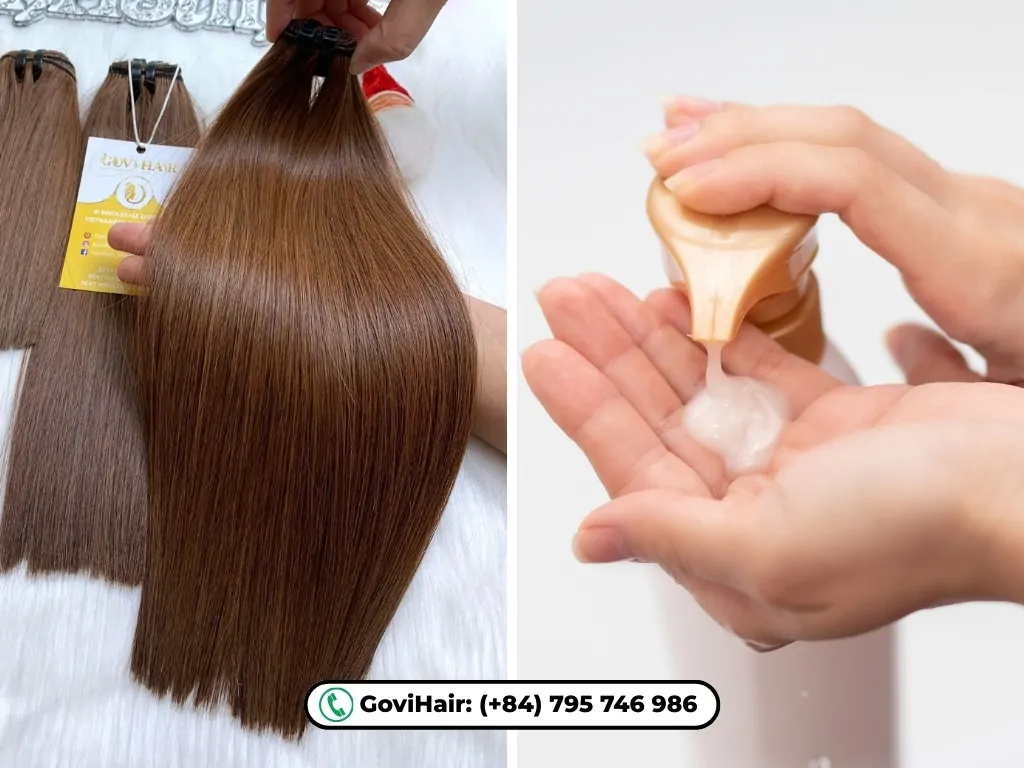
Frequency for Each Type of Extension
Every extension type has different washing needs. Follow these general guidelines to avoid overwashing or neglect:
- Clip-In Extensions: Wash every 15–20 wears or when product buildup is visible. Since clip-ins aren’t worn daily, they don’t need frequent washing. Always wash before storing if you’ve used styling products.
- Tape-In & Sewn-In Extensions: Wash every 7–10 days, depending on your lifestyle and oil production. These extensions are worn continuously, so regular gentle cleansing is important to keep both your natural scalp and extensions healthy.
- Synthetic Extensions: Wash every 4–6 weeks or only when they appear visibly dirty or smell unpleasant. Synthetic hair doesn’t absorb oil but can pick up odors and residue from the environment.
Washing your extensions just the right amount not too often, not too little, helps maintain their look, texture, and longevity. If you’re ever unsure, trust how they look and feel: when they lose their softness, shine, or start to smell, it’s time for a refresh.
How To Wash Hair Extensions: Tips For First-Time Users
Wearing hair extensions for the first time can be exciting, but it also comes with a learning curve. Whether you’re using extensions to add volume, length, or a pop of color, how you care for them in those first few uses sets the tone for their lifespan and performance. Here are two important questions first-time users often ask and what you really need to know.
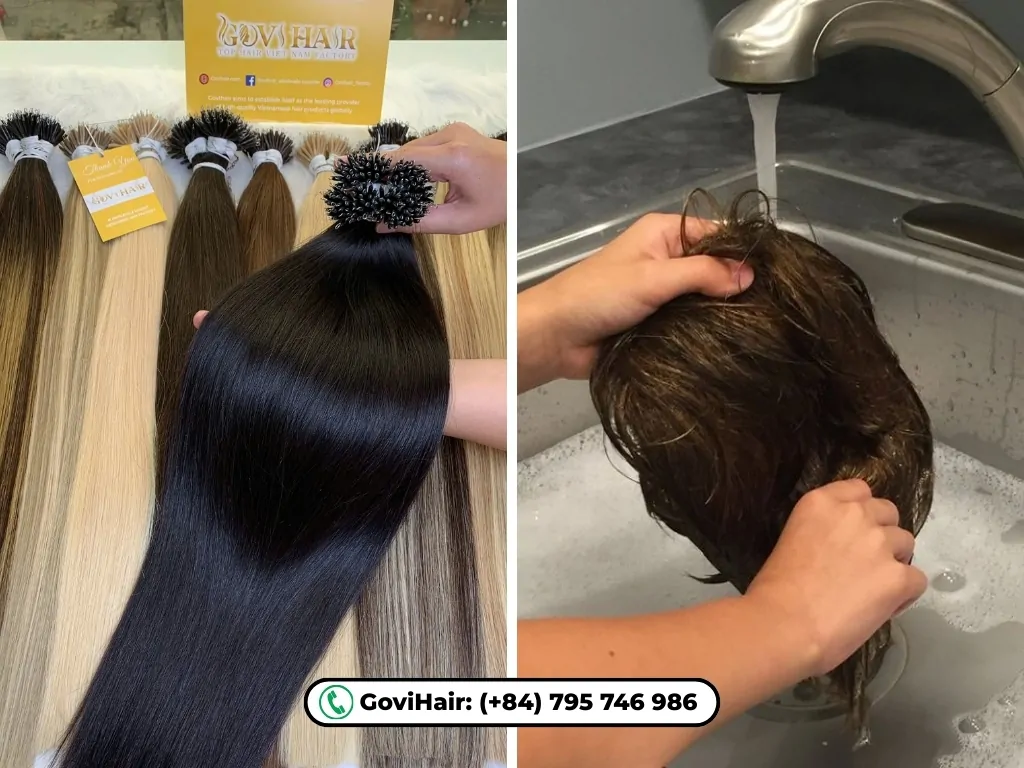
FAQs
Should You Wash Clip-In Hair Extensions Before Wearing Them?
Yes and here’s why. Even if your clip-in extensions arrive looking perfectly sleek, it’s a good idea to give them a gentle rinse before wearing them for the first time.
Why washing beforehand matters:
- Removes residue from manufacturing or packaging, which can include chemicals, starch, or coatings.
- Softens the wefts and opens up the texture, making them easier to blend seamlessly with your natural hair.
- Improves styling performance, especially if you’re planning to curl or straighten them after applying.
How to do it: Use cool or lukewarm water, apply a small amount of sulfate-free conditioner (no shampoo is needed for the first rinse unless they’re visibly dirty), and gently finger comb the strands before rinsing. Let them air dry completely before your first use.
Pro tip: Washing clip-ins before your first wear also helps you get comfortable handling and caring for them, which builds your confidence for future maintenance.
>> Explore More: What hair extension method lasts the longest?
Can You Wash Hair Extensions With Normal Shampoo?
Technically yes, but it’s strongly discouraged. Most regular shampoos are formulated for natural scalp oils and cleansing needs, not for detached hair like extensions.
Here’s why typical shampoos fall short:
- They often contain sulfates, parabens, and alcohol, which can strip the moisture from human hair extensions and cause synthetic ones to become stiff or frizzy.
- Some shampoos leave heavy residues that weigh extensions down and make them tangle more easily.
- Using the wrong product even once can shorten the lifespan of your extensions dramatically, especially for premium Remy hair.
Instead, choose a sulfate-free, alcohol-free shampoo specifically formulated for extensions or dry, color-treated hair. These products will clean gently while preserving softness, shine, and flexibility.
How to wash hair with extensions sewn in?
Gently cleanse your scalp using a diluted, sulfate-free shampoo. Massage in a downward motion to avoid tangling the weave. Rinse thoroughly and ensure both your natural hair and extensions dry completely to prevent odor or buildup.
What is the correct way to wash hair extensions?
Detangle the hair first, then wash using sulfate-free shampoo in smooth, downward strokes. Rinse well, apply conditioner to the mid-lengths and ends, and avoid scrubbing or twisting. Air drying is safest for maintaining softness and longevity.
Conclusion: How to Wash Hair Extensions for Long-Lasting Beauty
Learning how to wash hair extensions the right way doesn’t have to be complicated. With the proper technique, gentle care, and sulfate-free products, you can maintain their softness, shine, and durability. A consistent wash routine is the key to keeping your extensions fresh, flawless, and ready for every style.
For extensions that are easy to maintain and built to last, GoviHair offers premium, ethically sourced Vietnamese human hair. Our high-quality clip-ins, tape-ins, and wigs are made to stay flawless, wash after wash.
Chat with Us:
- WhatsApp: (+84) 795 746 986
- Email: [email protected]
- Instagram: govihair_vietnamhair_factory
- Tik Tok: govihairvietnam_official
- Website: govihair.com









 Ms. Jessica
Ms. Jessica